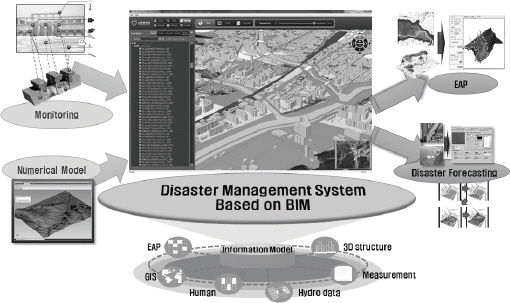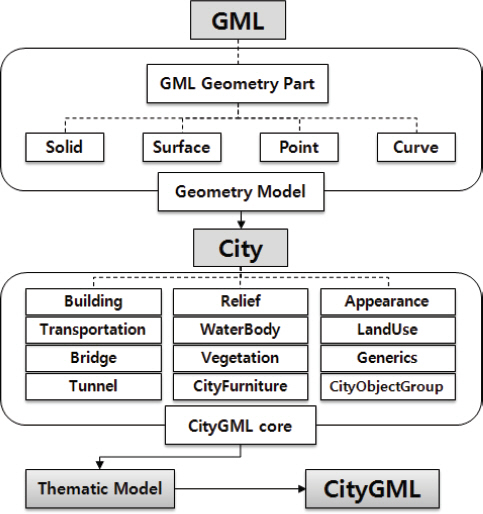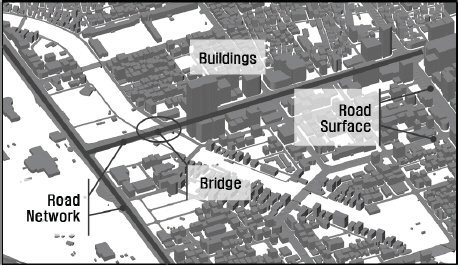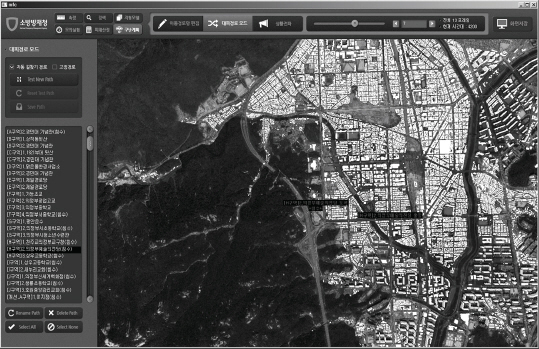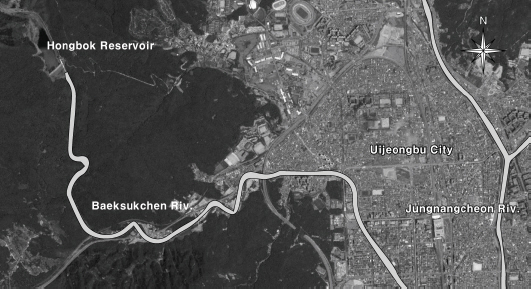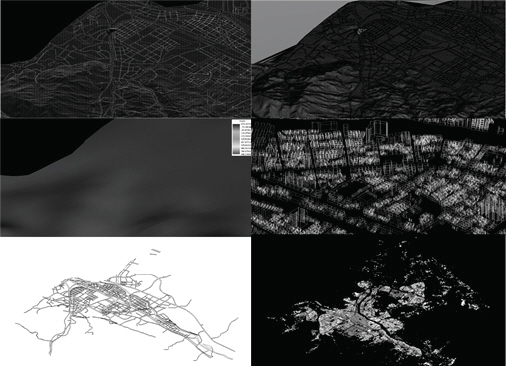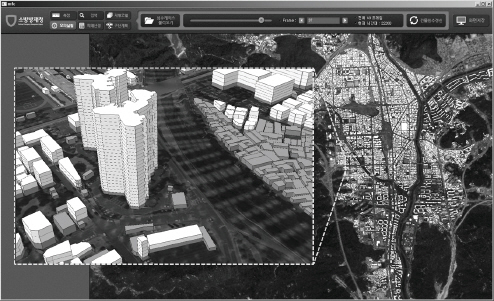 |
 |
- Search
| J. Korean Soc. Hazard Mitig. > Volume 17(3); 2017 > Article |
Abstract
Recently BIM technology is widely used in architectural and civil engineering fields for designing and maintenance control. BIM is process involving the generation and management of digital representations of physical and functional characteristics of places. In this research, we developed the integrated disaster management system using BIM technology and applied it to reservoir break or flood inundation disaster in Uijeongbu city, Korea. Hydrological and hydraulic modeling were combined with BIM technology. To overcome computational burden, resolution problem and the limit of data, concept of LOD was used. City Geography Markup Language was used as a BIM system for standard. Hybrid method combing 1D and 2D hydrologic & hydraulic modeling was also used to reduce the computational burden. We suggested 3D EAP for Hongbok reservoir in Uijeongbu city, Korea. Many important forecasted data such as flood depth, inundation area, evacuation path can be calculated and visualized through the system in accordance with reservoir break scenario. Preemptive disaster management can possible using this system for the decision makers and citizens. This methodology can be applied for various disaster using established base BIM map system and each hydrological and hydraulic model.
ņÜöņ¦Ć
ņĄ£ĻĘ╝ BIM ĻĖ░ņłĀņØĆ Ļ▒┤ņČĢ ļ░Å ĒåĀļ¬® ņŚöņ¦Ćļŗłņ¢┤ļ¦ü ļČäņĢ╝ņŚÉņä£ ņäżĻ│äņÖĆ ņŗ£ņäżļ¼╝ ņ£Āņ¦ĆĻ┤Ćļ”¼ņŚÉ Ļ┤æļ▓öņ£äĒĢśĻ▓ī ņé¼ņÜ®ļÉśĻ│Ā ņ׳ļŗż. BIMņØĆ Ļ│ĄĻ░äņØś ļ¼╝ļ”¼ņĀü ļ░Å ĻĖ░ļŖźņĀü ĒŖ╣ņä▒ņØä ņĀäņé░ĒÖöļÉ£ ņĀĢļ│┤ņØś ĒśĢĒā£ļĪ£ ņāØņä▒ĒĢśĻ│Ā Ļ┤Ćļ”¼ĒĢśļŖö Ļ│╝ņĀĢņØ┤ļŗż. ļ│Ė ņŚ░ĻĄ¼ņŚÉņä£ļŖö BIM ĻĖ░ņłĀņØä ņØ┤ņÜ®ĒĢśņŚ¼ ĒåĄĒĢ®ļ░®ņ×¼ņŗ£ņŖżĒģ£ņØä ĻĄ¼ņä▒ĒĢśĻ│Ā ņØśņĀĢļČĆņŗ£ ĒÖŹļ│ĄņĀĆņłśņ¦Ć ļČĢĻ┤┤ ņŗ£ļéśļ”¼ņśżņŚÉ ņĀüņÜ®ĒĢśņŚ¼ ĻĘĖ ĒÖ£ņÜ®ņä▒ņØä ĒÖĢņØĖĒĢśņśĆļŗż. ņłśļ¼Ė ļ░Å ņłśļ”¼ĒĢÖņĀü ņłśņ╣śļ¬©ĒśĢņØä BIM ĻĖ░ņłĀĻ│╝ Ļ▓░ĒĢ®ĒĢśņśĆņ£╝ļ®░, ņłśņ╣śļ¬©ņØśļź╝ ņ£äĒĢ┤ ĒĢäņÜöĒĢ£ Ļ│äņé░ ņ×ÉņøÉņØś ĒĢ£Ļ│äņÖĆ ĒĢ┤ņāüļÅä ļ¼ĖņĀ£ļź╝ ĒĢ┤Ļ▓░ĒĢśĻĖ░ ņ£äĒĢ┤ LOD Ļ░£ļģÉņØä ņĀüņÜ®ĒĢśņśĆļŗż. CityGMLņØä BIM ņŗ£ņŖżĒģ£ņØä ĻĄ¼ņä▒ĒĢśĻĖ░ ņ£äĒĢ£ Ēæ£ņżĆņ£╝ļĪ£ ņäżņĀĢĒĢśņśĆņ£╝ļ®░, 1ņ░©ņøÉ ļ░Å 2ņ░©ņøÉ ņłśļ”¼ ņłśļ¼Ė ļ¬©ĒśĢņØä ĒĢäņÜöņŚÉ ļö░ļØ╝ ļ│ĄĒĢ®ņĀüņ£╝ļĪ£ ĒÖ£ņÜ®ņØä ĒĢ©ņ£╝ļĪ£ņŹ© ņłśņ╣śļ¬©ņØś Ļ│äņé░ ņāüņØś ļČĆļŗ┤ņØä ņĀĆĻ░ÉĒĢśņśĆļŗż. ļ│Ė ņŚ░ĻĄ¼ļź╝ ĒåĄĒĢ┤ Ļ░£ļ░£ļÉ£ ĒåĄĒĢ®ļ░®ņ×¼ņŗ£ņŖżĒģ£ņØä ĒÖ£ņÜ®ĒĢśņŚ¼ ņØśņĀĢļČĆņŗ£ ĒÖŹļ│ĄņĀĆņłśņ¦ĆņØś 3ņ░©ņøÉ EAPņØś ņśłņŗ£ļź╝ ņłśļ”ĮĒĢśņśĆļŗż. ļ│Ė ņŗ£ņŖżĒģ£ņØä ĒåĄĒĢ┤ ļīÉ ļČĢĻ┤┤ ņŗ£ļéśļ”¼ņśżņŚÉ ļīĆņØæĒĢśļŖö ņ╣©ņłśņŗ¼, ņ╣©ņłśļ®┤ņĀü, ļīĆĒö╝Ļ▓ĮļĪ£ ļō▒ņØä ņé░ņĀĢĒĢśĻ│Ā ĻĘĖ Ļ▓░Ļ│╝ļź╝ Ļ░Ćņŗ£ĒÖöĒĢśņśĆļŗż. ļ│Ė ņŚ░ĻĄ¼ņŚÉņä£ Ļ░£ļ░£ĒĢ£ ņŗ£ņŖżĒģ£ņØä ĒåĄĒĢ┤ ņØśņé¼Ļ▓░ņĀĢņ×ÉņÖĆ ņØ╝ļ░ś ņŗ£ļ»╝ņØä ņ£äĒĢ£ ņäĀņĀ£ņĀüņØĖ ņ×¼ļé£Ļ┤Ćļ”¼Ļ░Ć Ļ░ĆļŖźĒĢĀ Ļ▓āņ£╝ļĪ£ ĒīÉļŗ©ļÉśļ®░, ļ│Ė ņŚ░ĻĄ¼ņØś ļ░®ļ▓ĢļĪĀņØĆ BIMņØä ĻĖ░ļ░śņ£╝ļĪ£ ņ×æņä▒ļÉ£ Ļ│ĄĻ░ä ņŗ£ņŖżĒģ£Ļ│╝ ņ×¼ļé£ņØä ņśłņĖĪĒĢĀ ņłś ņ׳ļŖö ņłśņ╣śļ¬©ĒśĢņØä ņØ┤ņÜ®ĒĢśņŚ¼ ļŗżņ¢æĒĢ£ ņ×¼ļé£ņŚÉ ņĀüņÜ® Ļ░ĆļŖźĒĢĀ Ļ▓āņ£╝ļĪ£ ĻĖ░ļīĆļÉ£ļŗż.
Ļ▒┤ņČĢļČäņĢ╝ļź╝ ņżæņŗ¼ņ£╝ļĪ£ ņŗ£ņ×æļÉ£ BIM (Building Information Modeling)ĻĖ░ņłĀņØ┤ ĒåĀļ¬®ļČäņĢ╝ļĪ£ ĒÖĢņé░ļÉśņ¢┤ņ¦ĆĻ│Ā ņ׳ļŗż(Cerovsek, 2011). BIM ĻĖ░ņłĀņØĆ ĻĖ░ņĪ┤ņØś 2ņ░©ņøÉņĀüņØĖ ņäżĻ│äļź╝ 3ņ░©ņøÉņ£╝ļĪ£ ĒÖĢņןĒĢśņśĆĻ│Ā ņØ┤ņŚÉ Ļ░üņóģ ņåŹņä▒ņØä ļŹöĒĢśņŚ¼ 4D, 5D, 6D ļō▒ņ£╝ļĪ£ ĒÖĢņןļÉśĻ│Ā ņ׳ļŗż. ĻĖ░ņĪ┤ņØś CAD, GIS ļō▒ņØ┤ ņäżĻ│äņÖĆ ņŗ£Ļ│ĄļČäņĢ╝ņŚÉņä£ ĻĄŁĒĢ£ļÉśņ¢┤ ņé¼ņÜ®ļÉśņ¢┤ņĪīļŗżļ®┤, BIMņØĆ ņäżĻ│ä, ņŗ£Ļ│Ą, Ļ│ĄņĀĢĻ┤Ćļ”¼, ņ£Āņ¦ĆĻ┤Ćļ”¼, ņāüĒÖ®Ļ┤Ćļ”¼ ļō▒ ņŚ¼ļ¤¼ ļČäņĢ╝ņŚÉņä£ ĒÖ£ņÜ®ļÉśņ¢┤ņ¦ĆĻ│Ā ņ׳ļŗż(Hardin, 2009). ļ░®ņ×¼ļČäņĢ╝ņŚÉņä£ņØś ĒÖ£ņÜ®ņØĆ ņĄ£ĻĘ╝Ļ╣īņ¦ĆļŖö ĒÖöņ×¼, ņ¦Ćņ¦ä ļ░Å ĒÖŹņłś ļō▒ņ£╝ļĪ£ ņØĖĒĢ£ ĻĄ¼ņĪ░ļ¼╝ ļČłņĢłņĀĢ ļō▒ ļŗ©ņØ╝ ĻĄ¼ņĪ░ļ¼╝ņŚÉņä£ ļ░£ņāØĒĢ£ ņ×¼ļé£ ņāüĒÖ®ņŚÉņØś ļīĆņØæņŚÉļ¦ī ĻĄŁĒĢ£ļÉśņ¢┤ ņ׳ņ£╝ļéś ļŗżņ¢æĒĢ£ ņ×¼ļé£Ļ┤Ćļ”¼ ņ¢┤Ēöīļ”¼ņ╝ĆņØ┤ņģśņØś Ļ░£ļ░£Ļ│╝ ĒĢ©Ļ╗ś ĻĘĖ ĒÖ£ņÜ® ļ▓öņ£äļź╝ ļäōĒśĆĻ░ĆĻ│Ā ņ׳ļŗż(Treado et al., 2007).
ņ¦ĆĻĖłĻ╣īņ¦Ć ņłśĻ│ĄļČäņĢ╝ņŚÉņä£ļŖö ļ¬©ļŹĖļ¦ü Ļ▓░Ļ│╝ļź╝ Ēæ£ņČ£ĒĢĀ ļĢī GISļź╝ ņŻ╝ļĪ£ ĒÖ£ņÜ®ĒĢśņśĆļŗż(Singh and Fiorentino, 2013). ņ×ģļĀź ņ×ÉļŻīņØś ĻĄ¼ņČĢņØä ņ£äĒĢ┤ņä£ ņé¼ņÜ®ļÉśņ¢┤ņ¦ä GISļŖö Ļ▓░Ļ│╝ņØś Ēæ£ņČ£ņŚÉņä£ļÅä 2ņ░©ņøÉņĀüņØĖ ņŗ£Ļ░ü Ēæ£ņČ£ņØ┤ Ļ░ĆļŖźĒ¢łĻ│Ā Ļ│╝Ļ▒░ ļÅäļ®┤ ņ£äņŻ╝ņØś Ēæ£ņČ£ņŚÉ ļ╣äĒĢ┤ ļ¦ÄņØĆ ņןņĀÉņØä Ļ░Ćņ¦ĆĻ│Ā ņ׳ņŚłļŗż(Sarhadi et al., 2012). ņĄ£ĻĘ╝ ļ░£ļŗ¼ļÉ£ 2ņ░©ņøÉ, 3ņ░©ņøÉ ņłśļ”¼ ļ¬©ĒśĢņŚÉņä£ ņāØņé░ļÉśļŖö ļŗżņ¢æĒĢ£ ņĀĢļ│┤ņÖĆ ņØ┤ļź╝ ļ░śņśüĒĢśĻĖ░ ņ£äĒĢ┤ņä£ļŖö ņØ┤ņĀ£ļŖö ļ│äļÅäņØś Ēæ£ņČ£ņŗ£ņŖżĒģ£ņØ┤ ĒĢäņÜöĒĢśĻ▓ī ļÉśņŚłĻ│Ā ņØ┤ļ¤¼ĒĢ£ ņÜöĻĄ¼ņé¼ĒĢŁņØä ņל ļ░śņśüĒĢĀ ņłś ņ׳ļŖö ĻĖ░ņłĀņØ┤ BIMņØ┤ļŗż.
ņłśĻ│Ą ļČäņĢ╝ņŚÉņä£ļŖö ņĀäĒåĄņĀüņØĖ BIM ĻĖ░ņłĀ ļ│┤ļŗżļŖö ņłśĻ│Ą ļČäņĢ╝ņØś Ļ│ĄĻ░äņĀüņØĖ Ļ┤æļ▓öņ£äņä▒ņ£╝ļĪ£ ņØĖĒĢ£ ļŹ░ņØ┤Ēä░ņØś ļ¼ĖņĀ£ļź╝ ĒĢ┤Ļ▓░ĒĢśĻĖ░ ņ£äĒĢ┤ Ēæ£ņČ£ņØś ņĀĢļÅäļź╝ ņĪ░ņĀłĒĢśļŖö LOD (Level of Detail) (Bedrick, 2008) Ļ░£ļģÉņØä ņĀüņÜ®ĒĢśņŚ¼ ļ░śņśüĒĢśĻ│Ā City Geography Markup Language (CityGML) ļō▒Ļ│╝ Ļ░ÖņØĆ Ļ░£ļ░®ņĀüņØ┤Ļ│Ā ņ¦ĆĒśĢĻ│ĄĻ░äņĀĢļ│┤ņØś Ēæ£ņČ£ņØ┤ Ļ░ĆļŖźĒĢ£ BIM Ēæ£ņżĆ ĻĖ░ņłĀņØś ņĀ£ņĢłņØ┤ ņÜöĻĄ¼ļÉ£ļŗż(de Laat and van Berlo, 2011). ĒŖ╣Ē׳ BIM ĻĖ░ņłĀņØ┤ Ļ░Ćņ¦ĆļŖö ņŗ£Ļ░üĒÖö ĻĖ░ņłĀĻ│╝ Ēæ£ņČ£ĻĖ░ļŖźņØĆ Ļ┤Ćļ”¼ņ×ÉņØś ļŗżņżæņØśņé¼Ļ▓░ņĀĢĻ│╝ ĻĄŁļ»╝ņØś ņ×¼ĒĢ┤ņŚÉ ļīĆĒĢ£ ņØ┤ĒĢ┤ņÖĆ ļīĆļ╣äļź╝ ļÅäņÜĖ ņłś ņ׳ļŖö ņóŗņØĆ ļÅäĻĄ¼Ļ░Ć ļÉĀ Ļ▓āņØ┤ļŗż.
ņ×¼ļé£ ļ░£ņāØņāüĒÖ®ņØä ņé¼ņĀäņŚÉ ļ¬©ņØśĒĢśĻ│Ā ļīĆņ▓śļ░®ņĢłņØä 3ņ░©ņøÉ ĒśĢņāüņĀĢļ│┤ļĪ£ Ļ░Ćņŗ£ĒÖöĒĢśĻĖ░ ņ£äĒĢ┤ņä£ļŖö Ļ│äņĖĪ ļ░Å ļ¬©ļŗłĒä░ļ¦ü ļŹ░ņØ┤Ēä░ņÖĆ ņłśļ░®ņŗ£ņäżļ¼╝ņŚÉ ļīĆĒĢ£ ņåŹņä▒ņĀĢļ│┤, ĻĘĖļ”¼Ļ│Ā ĒÖŹņłśĒö╝ĒĢ┤ ņśłņāüņ¦ĆņŚŁņŚÉ ļīĆĒĢ£ 3ņ░©ņøÉ Ļ│ĄĻ░äņĀĢļ│┤ņØś ņĀ£Ļ│ĄņØ┤ ĒĢäņÜöĒĢśļŗż. ļö░ļØ╝ņä£ Ļ░ü ņÜöņåīļōżņØś ĒåĄĒĢ® ņĀĢļ│┤ņÖĆ 3ņ░©ņøÉ ĒśĢņāüņĀĢļ│┤ļź╝ ņØ┤ņÜ®ĒĢśņŚ¼ ĻĄ¼ņČĢļÉśļŖö BIM ļ¬©ļŹĖĻ│╝ ņłśļ░®ņŗ£ņäżļ¼╝ņŚÉ ļīĆĒĢ£ ļŹ░ņØ┤Ēä░ Ļ│äņĖĪ ļ░Å ļ¬©ļŗłĒä░ļ¦üņØä ĒåĄĒĢ┤ ņ▓┤Ļ│äĒÖöļÉ£ ļŹ░ņØ┤Ēä░ļČäņäØ, ĻĘĖļ”¼Ļ│Ā ļ╣äņāüļīĆņ▓śĻ│äĒÜŹņŚÉ ļö░ļźĖ ņ×¼ĒĢ┤ņāüĒÖ® Ē¢ēļÅÖņĪ░ņ╣ś ņŗ£ļ«¼ļĀłņØ┤ņģśņØ┤ ņŚ░Ļ│äļÉ£ ļŖźļÅÖĒśĢ ĒåĄĒĢ® ļ░®ņ×¼ ņŗ£ņŖżĒģ£ņØś Ļ░£ļ░£ņØ┤ ĒĢäņÜöĒĢśļ®░, ĻĄ¼ņČĢļÉśļŖö 3ņ░©ņøÉ BIM ĻĖ░ņłĀņØä ĒÖ£ņÜ®ĒĢ£ ņ×¼ļé£Ļ┤Ćļ”¼ ņŗ£ņŖżĒģ£ņØĆ ņłśļ░®ņŗ£ņäżļ¼╝ņØś ņāüĒÖ®Ļ┤Ćļ”¼ņÖĆ Ēö╝ĒĢ┤ ņĀĆĻ░ÉņŚÉ ĒÜ©Ļ│╝ņĀüņØĖ ļÅäĻĄ¼ļĪ£ ĒÖ£ņÜ®ļÉĀ ņłś ņ׳ļŗż.
BIM ĻĖ░ņłĀĻ│╝ ņłśļ”¼Ōŗģņłśļ¼Ėļ¬©ĒśĢņØä ņŚ░Ļ│äĒĢśĻĖ░ ņ£äĒĢ┤ņä£ļŖö ļ©╝ņĀĆ ņłśļ”¼Ōŗģņłśļ¼Ėļ¬©ĒśĢņØś ĻĄ¼ņČĢņØ┤ ņÜ░ņäĀļÉśņ¢┤ņĢ╝ ĒĢśļ®░ ņØ┤ļź╝ ĒåĄĒĢ┤ ņāØņä▒ļÉśļŖö ņ×ÉļŻīļź╝ BIM ĻĖ░ņłĀĻ│╝ ņŚ░ļÅÖĒĢśņŚ¼ņĢ╝ ĒĢ£ļŗż. ņ×¼ļé£Ōŗģņ×¼ĒĢ┤ ņāüĒÖ®ņØä ļ¬©ņØśĒĢĀ ņłś ņ׳ļŖö ņłśļ”¼ļ¬©ĒśĢņØä 3ņ░©ņøÉņ£╝ļĪ£ Ļ░Ćņŗ£ĒÖöĒĢśĻĖ░ ņ£äĒĢ┤ Ļ░ĢņÜ░-ņ£ĀņČ£ļ¬©ĒśĢĻ│╝ ņłśļ░®ĻĄ¼ņĪ░ļ¼╝ ļČĢĻ┤┤ ļ¬©ņØśļź╝ ĒåĄĒĢ£ 1ņ░©ņøÉĻ│╝ 2ņ░©ņøÉ ņłśļ”¼ļ¬©ĒśĢ ĒĢ┤ņäØņØä Ļ▓░ĒĢ®ĒĢ£ ņłśļ”¼ļ¬©ĒśĢņØä ĻĄ¼ņČĢĒĢ£ļŗż. ĻĄ¼ņČĢļÉ£ ņłśļ”¼Ōŗģņłśļ¼Ėļ¬©ĒśĢņØĆ BIM ĻĖ░ņłĀņØä ĒÖ£ņÜ®ĒĢśņŚ¼ ņłśļ”ĮļÉ£ Ļ│ĄĻ░äņĀĢļ│┤ ņŗ£ņŖżĒģ£Ļ│╝ ņóīĒæ£ņ▓┤Ļ│äļź╝ Ļ│Ąņ£ĀĒĢśņŚ¼ņĢ╝ ĒĢśļ®░, Ļ░Ćņŗ£ĒÖöĒĢśĻ│Āņ×É ĒĢśļŖö ĒĢ┤ņāüļÅäņŚÉ ņĀüĒĢ®ĒĢ┤ņĢ╝ ĒĢ£ļŗż.
Ēśäņ×¼ ņŻ╝ļĪ£ ņé¼ņÜ®ļÉśĻ│Ā ņ׳ļŖö ņłśļ”¼Ōŗģņłśļ¼Ė ļ¬©ĒśĢņØĆ GISļź╝ ĻĖ░ļ░śņ£╝ļĪ£ ļ¬©ņØśļź╝ ņłśĒ¢ēĒĢśĻ│Ā Ļ▓░Ļ│╝ļź╝ ņĀ£Ļ│ĄĒĢ£ļŗż. GISņÖĆ BIMņØĆ ņØ╝ļ░śņĀüņ£╝ļĪ£ Ļ│ĄĻ░äņĀĢļ│┤ļź╝ ĻĄ¼ņä▒ĒĢśļŖö ĒĢ┤ņāüļÅäĻ░Ć ņāüņØ┤ĒĢśļŗż. ļö░ļØ╝ņä£ GISņÖĆ BIMņØ┤ ļŹ░ņØ┤Ēä░ļ▓ĀņØ┤ņŖżļź╝ Ļ│Ąņ£ĀĒĢśĻ▓ī ĒĢśļŖö Ļ│╝ņĀĢņØ┤ ņÜöĻĄ¼ļÉśļŖöļŹ░, ļ│Ė ņŚ░ĻĄ¼ņŚÉņä£ļŖö ļæÉ ņŗ£ņŖżĒģ£ņØä ĒåĄĒĢ┤ ņłśļ”ĮĒĢśĻ│Ā ņĀ£Ļ│ĄĒĢśĻ│Āņ×É ĒĢśļŖö ņĀĢļ│┤ņØś LODļź╝ ļČäņäØĒĢśĻ│Ā, ņ×¼ļé£Ļ┤Ćļ”¼ņŚÉ ņÜöĻĄ¼ļÉśļŖö ņĀĢļ│┤ņØś ĒĢ┤ņāüļÅä ņłśņżĆņŚÉņä£ LODļź╝ Ļ▓░ņĀĢĒĢśņśĆļŗż.
ĻĖ░ņĪ┤ņØś EAP (Emergency Action Plan)ļŖö ļīÉĒĢśļźśļČĆ ņśüĒ¢źĒÅēĻ░ĆņŚÉ ļö░ļźĖ ļīĆĒö╝ņ¦ĆļÅä ņ×æņä▒ņŗ£ 2D ĒÖśĻ▓ĮņŚÉņä£ ĻĖ░ņłĀņ×ÉņØś ĒīÉļŗ©ņŚÉ ņØśĒĢ┤ ĒĢ£ ņןņØś ņóģņØ┤ļ¼Ėņä£ļĪ£ ņ×æņä▒ĒĢśĻĖ░ ļĢīļ¼ĖņŚÉ ņ▓┤Ļ│äņĀüņØĖ ņ×¼ļé£ļīĆņØæļŖźļĀźņØ┤ ļČĆņĪ▒ĒĢśļŗż. ļ░śļ®┤, BIMņØä ņØ┤ņÜ®ĒĢ£ ĒåĄĒĢ®ļ░®ņ×¼ņŗ£ņŖżĒģ£ņØĆ ļ╣äņāüņāüĒÖ® ļŗ©Ļ│äļ│ä ļ│┤Ļ│Ā ļ░Å ņĀäĒīīņ▓┤Ļ│ä, ļīĆĒö╝Ļ▓ĮļĪ£ļź╝ 3ņ░©ņøÉņ£╝ļĪ£ Ļ░Ćņŗ£ĒÖöĒĢśņŚ¼ ņŗĀņåŹĒĢ£ ļ╣äņāüļīĆņ▓śĻ│äĒÜŹ ĻĄ¼ņČĢņØ┤ Ļ░ĆļŖźĒĢśļŗż. ļ│Ė ņŚ░ĻĄ¼ļź╝ ĒåĄĒĢ┤ Ļ░£ļ░£ļÉ£ ĒåĄĒĢ®ļ░®ņ×¼ņŗ£ņŖżĒģ£ņØĆ ļ¬©ļŗłĒä░ļ¦ü ņ×ÉļŻī, ņłśņ╣śļ¬©ņØś Ļ▓░Ļ│╝ ļ┐Éļ¦ī ņĢäļŗłļØ╝ ĻĖ░ņĪ┤ņØś EAP (National Emergency Management Agency, 2009)ļź╝ ĒżĒĢ©ĒĢ£ ļŗżņ¢æĒĢ£ ņĀĢļ│┤ļź╝ ņŚ░Ļ│äĒĢśņŚ¼ 3ņ░©ņøÉ EAPņÖĆ ņ×¼ļé£ ņśłņĖĪ Ļ▓░Ļ│╝ļź╝ ņāØņé░ĒĢ£ļŗż(Fig. 1).
3ņ░©ņøÉ ļÅäņŗ£ņĀĢļ│┤ļ¬©ļŹĖļ¦ü ņĖĪļ®┤ņŚÉņä£ņØś ņ×¼ļé£ņśłļ░® ļśÉļŖö Ēö╝ĒĢ┤ ņĄ£ņåīĒÖöļŖö ņŗżņĀ£ņÖĆ ņ£Āņé¼ĒĢ£ ņāüĒÖ®ņØś ņŗ£ļ«¼ļĀłņØ┤ņģśņØä ņØ┤ņÜ®ĒĢ£ ņĀüĻĘ╣ņĀüņØĖ ņĪ░ņ╣śĻ│äĒÜŹ ņłśļ”ĮņØä ĒåĄĒĢ┤ Ļ░ĆļŖźĒĢśļŗż. ņØ┤ļ¤¼ĒĢ£ Ļ│╝ņĀĢņØĆ Ēü¼Ļ▓ī ŌĆśņ¢┤ļ¢ż ņĀĢļ│┤ĒĢŁļ¬®ņØä ļ░öĒāĢŌĆÖĒĢśņŚ¼, ŌĆśņ¢┤ļ¢ż ļ░®ņŗØņ£╝ļĪ£ ņĀĢļ│┤ļ¬©ļŹĖņØä ņāØņä▒ŌĆÖĒĢśĻ│Ā, ņØ┤ļź╝ ŌĆśņ¢┤ļ¢╗Ļ▓ī ĒÖ£ņÜ®ŌĆÖĒĢśļŖöĻ░ĆņŚÉ ļīĆĒĢ£ ļČĆļČäņ£╝ļĪ£ ļéśļłī ņłś ņ׳ļŗż. ņ¢┤ļ¢ż ņĀĢļ│┤ĒĢŁļ¬®ņØä ļ░öĒāĢņ£╝ļĪ£ ĒĢĀņ¦ĆņŚÉ ļīĆĒĢ£ ļ¼ĖņĀ£ļŖö ņØśņé¼Ļ▓░ņĀĢņØä ĒĢśĻ│Āņ×É ĒĢśļŖö ļ░öņØś ļ¬®ņĀüņŚÉ ļö░ļØ╝ ļŗ¼ļØ╝ņ¦ĆļŖö Ļ▓āņ£╝ļĪ£, ļÅäņŗ£ņ¦ĆņŚŁ ņ╣©ņłśĒĢ┤ ļ░£ņāØņØś Ļ▓ĮņÜ░ņŚÉļŖö ĒĢ┤ļŗ╣ ļÅäņŗ£ņ¦ĆņŚŁņØś ņ¦ĆĒśĢ, ĻĄ¼ņĪ░ļ¼╝ņØś ĻĖ░ļ│ĖņĀĢļ│┤ ļō▒ņØ┤ ĻĘĖ ņśłĻ░Ć ļÉĀ ņłś ņ׳ņ£╝ļ®░, ļČĆĻ░ĆņĀüņØĖ ĒĢŁļ¬®ņ£╝ļĪ£ ņłśļ”¼ĒĢ┤ņäØļŹ░ņØ┤Ēä░, Ļ│äņĖĪļŹ░ņØ┤Ēä░ ļō▒ļÅä ĒÖ£ņÜ®Ļ░ĆļŖźĒĢśļŗż. ņĀĢļ│┤ļ¬©ļŹĖņØä ņāØņä▒ĒĢśļŖö ļ░®ņŗØņŚÉ ņ׳ņ¢┤ņä£ļŖö ĒāĆ ņŗ£ņŖżĒģ£Ļ│╝ņØś ņĀĢļ│┤ņŚ░Ļ│ä ņŗĀļó░ņä▒, ņĀĢļ│┤ ĒÖ£ņÜ®ņØś ņŚ░ņåŹņä▒ ļ░Å ņĀĢļ│┤ ĒśĖĒÖśņä▒ņØä Ļ│ĀļĀżĒĢ┤ņĢ╝ ĒĢ£ļŗż. ņåÉņŗż ņŚåļŖö ņĀĢļ│┤ņØś ņĀĆņן ļśÉļŖö ņ×¼ņé¼ņÜ® ņ×Éņ▓┤Ļ░Ć ļ¬©ļŹĖņØś ĒÖ£ņÜ®Ļ│╝ ņ¦üņĀæņĀüņ£╝ļĪ£ ņŚ░Ļ▓░ļÉśļŖö Ļ▓āņ£╝ļĪ£, ņĀäņłĀĒĢ£ ĒĢŁļ¬®ļōżņØĆ ņ×¼ļé£ņśłļ░® ļśÉļŖö Ēö╝ĒĢ┤ņĄ£ņåīĒÖöļØ╝ļŖö ņĄ£ņóģ ļ¬®ņĀüņŚÉ ļö░ļźĖ ņĀĢļ│┤ ĒÖ£ņÜ®ņŚÉ ņóģņåŹļÉśļŖö Ļ▓āņØ┤ļØ╝ ĒĢĀ ņłś ņ׳ļŗż. ļö░ļØ╝ņä£ Ļ│äĒÜŹļŗ©Ļ│äņŚÉņä£ļČĆĒä░ ļ¬©ļŹĖņØś ĒÖ£ņÜ®ņŚÉ ņØ┤ļź┤ĻĖ░Ļ╣īņ¦Ć ņØ╝Ļ┤ĆļÉ£ ĒśĢĒā£ņØś ĒöäļĀłņ×ä ļé┤ņŚÉņä£ ņĀĢļ│┤Ļ░Ć ņāØņä▒ļÉśĻ│Ā Ļ┤Ćļ”¼ļÉśņ¢┤ņĢ╝ ĒĢ£ļŗż.
ņĀĢļ│┤ņØś ĒØÉļ”äņ░©ņøÉņŚÉņä£ 3ņ░©ņøÉ ļÅäņŗ£ņĀĢļ│┤ļ¬©ļŹĖĻĖ░ļ░ś ņāØņä▒ņĀĢļ│┤ņŚ░Ļ│ä ļ░Å ņ×¼ĒÖ£ņÜ®ņØś Ļ░Ćņן ņżæņČöņĀüņØĖ ĒöäļĀłņ×äņØś ņŚŁĒĢĀņØä ĒĢśļŖö Ļ▓āņØ┤ ļŹ░ņØ┤Ēä░ ņŖżĒéżļ¦ł(ĒŗĆ)ļØ╝Ļ│Ā ĒĢĀ ņłś ņ׳ļŗż. ļŹ░ņØ┤Ēä░ ņŖżĒéżļ¦łļŖö ņ¢┤ļ¢ĀĒĢ£ ņĀĢļ│┤ĒĢŁļ¬®ņØä ņ¢┤ļ¢ż ņåŹņä▒ņØä Ļ░Ćņ¦ĆļŖö ĒśĢĒā£ļĪ£ ņ¢┤ļ¢╗Ļ▓ī Ēæ£ĒśäĒĢ┤ņĢ╝ĒĢśļŖöņ¦Ć ņČöņāüĒÖöļÉ£ Ļ░Øņ▓┤ļź╝ ĒÖ£ņÜ®ĒĢśņŚ¼ ņé¼ņĀäņŚÉ ņØ┤ļź╝ ņĀĢĒĢ┤ļåōļŖö Ļ▓āņ£╝ļĪ£, ņ×¼ļé£ņāüĒÖ® ņé¼ņĀä ņŗ£ļ«¼ļĀłņØ┤ņģśņŚÉ ņĀüņÜ®ĒĢśĻĖ░ņŚÉ Ļ░Ćņן ņĀüĒĢ®ĒĢ£ ĒśĢĒā£ņØś ļŹ░ņØ┤Ēä░ ņŖżĒéżļ¦łļŖö 1) ņĀĢļ│┤ļ¬©ļŹĖņØś 3ņ░©ņøÉ Ļ░Ćņŗ£ņä▒(visualization), 2) ļÅäņŗ£Ļ░Øņ▓┤ņØś Ēæ£ĒśäĻ░ĆļŖźņä▒ņŚÉ ļīĆĒĢ£ ĒżĻ┤äņä▒(comprehensiveness), 3) ņé¼ņÜ®ņ×É ļśÉļŖö ļ¬©ļŹĖ ņāØņä▒ņ×ÉņŚÉ ņØśĒĢ£ ņé¼ņÜ®ņ×ÉņĀĢņØś ņĀĢļ│┤ĒĢŁļ¬® ņČöĻ░ĆņŚÉ ļīĆĒĢ£ ĒÖĢņןņä▒(extensible), 4) ĻĖ░ņĪ┤ ņåīĒöäĒŖĖņø©ņ¢┤ļź╝ ĒåĄĒĢ£ ņĀĢļ│┤ļ¬©ļŹĖņØś ļé┤ļČĆ ņåŹņä▒ ņĀ£ņ¢┤Ļ░ĆļŖźņä▒ņØś ļäż Ļ░Ćņ¦ĆņØś ĒĢŁļ¬®ņØä Ļ│ĀļĀżĒĢśņŚ¼ ņäĀņĀĢĒĢĀ ĒĢäņÜöĻ░Ć ņ׳ļŗż. ņØ┤ļ¤¼ĒĢ£ ĻĖ░ņżĆņØä Ļ│ĀļĀżĒ¢łņØä ļĢī, ņĀüĒĢ®ĒĢ£ ĒśĢĒā£ņØś ļŹ░ņØ┤Ēä░ ņŖżĒéżļ¦ł ņżæņŚÉ ĒĢśļéśĻ░Ć CityGMLņØ┤ļŗż(Gr├Čger et al., 2008).
CityGMLņŚÉņä£ ņĀĢļ│┤ĒĢŁļ¬®ņØś ņØśļ»ĖņĀĢļ│┤ ņāØņä▒ņØĆ Fig. 2ņÖĆ Ļ░ÖņØ┤ Ēæ£ĒśäĒĢśĻ│Āņ×É ĒĢśļŖö ĒĢŁļ¬®ņØś ĒśĢņāüņŚÉ ĻĖ░ļŖźņĀüņØĖ ņŚŁĒĢĀņØä ļČĆņŚ¼ĒĢśļŖö ļ░®ņŗØņ£╝ļĪ£ ņØ┤ļŻ©ņ¢┤ņ¦Ćļ®░, ņØ┤ļŖö ĻĄ¼ņĪ░ļ¼╝ļŗ©ņ£äļ┐Éļ¦ī ņĢäļŗłļØ╝ ĻĄ¼ņĪ░ļ¼╝ņØä ņØ┤ļŻ©Ļ│Ā ņ׳ļŖö ņäĖļČĆ ņÜöņåīņŚÉļÅä ņĀüņÜ®ĒĢĀ ņłś ņ׳ļŗż. CityGMLņŚÉņä£ Ļ│äņĖĄĻ┤ĆĻ│äņŚÉ ļīĆĒĢ£ ņĀĢļ│┤ņØś ņāØņä▒ņØĆ ĻĖ░ļŖźņĀü ņŚŁĒĢĀņŚÉ ļö░ļØ╝ ņĀĢļ│┤ĒĢŁļ¬®ņØä ĻĘĖļŻ╣ĒĢśņŚ¼ Ļ│äņĖĄņØä ņāØņä▒ĒĢśĻ│Ā ņØ┤ļź╝ ļŹ░ņØ┤Ēä░Ļ░Ć ĒżĒĢ©ļÉ£ ņĀĢļ│┤ļ¬©ļŹĖņØä ņāØņä▒ĒĢĀ ļĢī ļ░śņśüĒĢśņŚ¼ ņżĆļŗż.
3ņ░©ņøÉ ļÅäņŗ£ņĀĢļ│┤ļ¬©ļŹĖņØś ĒÖ£ņÜ®Ļ│╝ Ļ┤ĆļĀ©ļÉśļŖö ņ×¼ļé£ņāüĒÖ® ņŗ£ļ«¼ļĀłņØ┤ņģśņØä ĒåĄĒĢ┤ ņ¢╗Ļ│Āņ×É ĒĢśļŖö Ļ▓░Ļ│╝ļŖö ļŹ░ņØ┤Ēä░ ņŖżĒéżļ¦łņØś ņ░©ņøÉņŚÉņä£ ņÜöņåīĻ░Ć ļ░śņśüļÉśņ¢┤ ņ׳ņ¢┤ņĢ╝ ĒĢśļ®░, ņĀĢļ│┤ļ¬©ļŹĖ ņāØņä▒ ņŗ£ Ļ▓░Ļ│╝ļź╝ ņĀĆņןĒĢĀ ņłś ņ׳ļŖö Ļ│ĄĻ░äņØä ļ¬©ļŹĖ ļé┤ļČĆ ļśÉļŖö ņÖĖļČĆņŚÉ ļ¦łļĀ©ĒĢ┤ ļæÉĻ│Ā ņ׳ņ¢┤ņĢ╝ ĒĢ£ļŗż. ļÅäņŗ£ ņ╣©ņłśĻ░Ć ļ░£ņāØĒĢ£ ņāüĒÖ®ņØä Ļ░ĆņĀĢĒ¢łņØä Ļ▓ĮņÜ░ņŚÉļŖö ņśłņāü ņØĖļ¬ģ ļ░Å ņ×Éņé░Ēö╝ĒĢ┤ ņé░ņĀĢĻ│╝ Ļ┤ĆļĀ©ĒĢ┤ņä£ļŖö ņŚ░ļĀ╣ļ│ä ņØĖĻĄ¼, ņןņĢĀņ×É ļ╣äņ£©, ļ¼╝Ļ░Ćņ¦Ćņłś, Ļ▒┤ļ¼╝ņ×Éņé░Ļ░Ćņ╣ś ļō▒ņØ┤ ĻĘĖ ņśłĻ░Ć ļÉĀ ņłś ņ׳ļŗż. ņ╣©ņłśņāüĒÖ®ņŚÉņä£ņØś ņśłņāüņØĖļ¬ģĒö╝ĒĢ┤ļéś ņ×Éņé░Ēö╝ĒĢ┤ Ļ▓░Ļ│╝ ņé░ņČ£ņØĆ ņØ┤ļōż Ļ▓░Ļ│╝ļź╝ ņĀüņĀłĒ׳ Ēæ£ĒśäĒĢĀ ņłś ņ׳ļŖö ņØ┤ļĪĀņØä ņĀĢļ│┤ļ¬©ļŹĖ ņāüņŚÉ ļ░śņśüĒĢĀ ņłś ņ׳ļŖöļŹ░, Ļ▓░Ļ│╝ Ļ░Æ ņé░ņČ£ņØä ņ£äĒĢ£ ņ×ģļĀźņĀĢļ│┤ļŖö 3ņ░©ņøÉ ļÅäņŗ£ņĀĢļ│┤ļ¬©ļŹĖņŚÉņä£ ņ¦üņĀæ ņČöņČ£ņØ┤ Ļ░ĆļŖźĒĢśĻ│Ā, ņČ£ļĀźņĀĢļ│┤ļŖö ļ»Ėļ”¼ ļ¦łļĀ©ĒĢ┤ ļæÉĻ│Ā ņ׳ļŖö ņĀĆņןĻ│ĄĻ░äņāüņŚÉ Ļ▓░Ļ│╝ Ļ░ÆņØä ņāØņä▒ĒĢśņŚ¼ ļÅäņŗ£ņĀĢļ│┤ļ¬©ļŹĖĻ│╝ ņŚ░Ļ│äĒĢĀ ņłś ņ׳ļŗż.
Fig. 3ņØĆ ĒĢäņÜöĒĢ£ ĒĢŁļ¬®ņØä ļ░śņśüĒĢśņŚ¼ ņāØņä▒ĒĢ£ CityGMLĻĖ░ļ░śņØś 3ņ░©ņøÉ ļÅäņŗ£ņĀĢļ│┤ļ¬©ļŹĖņØś ņØ╝ļČĆļź╝ ļéśĒāĆļéĖ Ļ▓āņØ┤ļŗż. ņ¦ĆĒśĢļ¬©ļŹĖņØĆ ļ¬©ļōĀ ĻĄ¼ņĪ░ļ¼╝ņØś ņ£äņ╣śņĀĢļ│┤ Ļ┤Ćļ”¼ļź╝ ņ£äĒĢ£ ņżæņŗ¼ ņŚŁĒĢĀņØä ņłśĒ¢ēĒĢĀ ņłś ņ׳ņ£╝ļ®░, ņØ┤ņŚÉ ļö░ļØ╝ ņ¦ĆņŚŁņĀü, ņĀäņŚŁņĀü ņóīĒæ£ņĀĢļ│┤ļź╝ Ļ░Ćņ¦ł ņłś ņ׳ļŗż. ļśÉĒĢ£ Ē¢ēņĀĢņĀĢļ│┤, ņ¦Ćņ¦łņĀĢļ│┤ ļō▒Ļ│╝ Ļ░ÖņØ┤ ņ¦ĆĒśĢņØ┤ Ļ░Ćņ¦ł ņłś ņ׳ļŖö ĻĖ░ļŖźĻ│╝ Ļ┤ĆļĀ©ĒĢ£ ņĀĢļ│┤ļź╝ ĒżĒĢ©ĒĢĀ ņłś ņ׳ļŗż. ļÅäļĪ£ļ¬©ļŹĖņØĆ ļÅäļĪ£ļ®┤Ļ│╝ Ļ┤ĆļĀ©ĒĢ£ ĒśĢņāüņĀĢļ│┤ņÖĆ ļÅäļĪ£ļäżĒŖĖņøīĒü¼ņÖĆ Ļ┤ĆļĀ©ĒĢ£ ņ¦ĆņĀÉļ│ä ņŚ░Ļ▓░ņĀĢļ│┤, ļÅäļĪ£ļ¬ģĻ│╝ Ļ┤ĆļĀ©ĒĢ£ Ē¢ēņĀĢņĀĢļ│┤ļź╝ ĒżĒĢ©ĒĢĀ ņłś ņ׳ļŗż. ļÅäļĪ£ļ¬©ļŹĖņØĆ ņ£äņ╣śņĀĢļ│┤ļź╝ ĒÖ£ņÜ®ĒĢśņŚ¼ ņ¦ĆĒśĢļ¬©ļŹĖņØ┤ ĒżĒĢ©ĒĢśĻ│Ā ņ׳ļŖö ĻĖ░ļŖźĻ┤ĆļĀ© ņĀĢļ│┤ļōżņØä ĒÖ£ņÜ®ĒĢĀ ņłś ņ׳ņ£╝ļ®░, ņ╣©ņłśĒĢ┤ ņāüĒÖ®ņØä Ļ░ĆņĀĢĒĢśļ®┤ ņ╣©ņłś ļÅäļĪ£ļ®┤ņØś ĒŖ╣ņĀĢņ£äņ╣śņŚÉņä£ņØś Ē¢ēņĀĢņĀĢļ│┤ ļō▒ņØä ņ¦üņĀæņĀüņ£╝ļĪ£ ņĀ£ņ¢┤ĒĢĀ ņłś ņ׳ļŗż. Ļ▒┤ļ¼╝ļ¬©ļŹĖņØ┤ ĒżĒĢ©ĒĢĀ ņłś ņ׳ļŖö ņåŹņä▒ņ£╝ļĪ£ļŖö Ļ▒┤ļ¼╝ ļśÉļŖö Ļ░ĆĻĄ¼ļ│ä ņØĖĻĄ¼ ņłś, ļīĆĒö╝ņŚÉ ņśüĒ¢źņØä ņżä ņłś ņ׳ļŖö ņØĖņĀü ĒśäĒÖ®(ņ£ĀņĢä, ļģĖņØĖ, ņןņĢĀņØĖļ╣äņ£© ļō▒), ņ×Éņé░Ēö╝ĒĢ┤ņĢĪ ņé░ņĀĢņŚÉ ĒĢäņÜöĒĢ£ ļŹ░ņØ┤Ēä░ļōż(Ļ▒┤ļ¼╝ĻĄ¼ņĪ░, ņ×¼ņé░ĒÅēĻ░Ć ĻĖ░ņżĆļģäļÅä, ļ¼╝Ļ░Ćņ¦Ćņłś ļō▒)ņØ┤ ņ׳ļŗż.
3ņ░©ņøÉ ļÅäņŗ£ņĀĢļ│┤ļ¬©ļŹĖļ¦ü ņŗ£ ņāØņä▒ĒĢ┤ ļåōņØĆ ņĀĢļ│┤ļōżņØĆ ņØśņé¼Ļ▓░ņĀĢņ¦ĆņøÉņØä ņ£äĒĢ┤ ļŗżņ¢æĒĢ£ ņĪ░ĒĢ®ņØä ĒåĄĒĢ┤ Ļ▓░Ļ│╝Ļ░Æ ļÅäņČ£ ņŗ£ļ«¼ļĀłņØ┤ņģśņØ┤ Ļ░ĆļŖźĒĢśļŗż. ņĀ£ļ░® ļČĢĻ┤┤ņŚÉ ļö░ļØ╝ ļÅäņŗ£ņ╣©ņłśĻ░Ć ļ░£ņāØĒĢ£ Ļ▓ĮņÜ░ņŚÉņä£ļŖö 1) ņ£äņ╣ś/ĒśĢņāüņĀü ņĖĪļ®┤ņØś ņÜöņåīņØĖ Ļ▒┤ļ¼╝ņØś ņ£äņ╣ś(GPS ņóīĒæ£Ļ│ä), Ļ▒┤ļ¼╝ņØś ļåÆņØ┤, Ļ▒┤ļ¼╝ņØś ļ®┤ņĀü ļō▒ņØä, 2) ĻĖ░ļŖźņĀü ņØśļ»ĖņĀĢļ│┤ ņĖĪļ®┤ņØś ņÜöņåīņØĖ Ļ▒┤ļ¼╝ņØ┤ļ”ä, Ļ▒┤ļ¼╝ĻĄ¼ņĪ░, Ļ▒┤ļ¼╝ņĖĄņłś, Ē¢ēņĀĢļÅÖ, ņØĖĻĄ¼ņłś, ņןņĢĀņØĖ ļ╣äņ£© ļō▒ņØä, ņśłņāü Ēö╝ĒĢ┤Ļ▓░Ļ│╝Ļ░Ć ļÅäņČ£ļÉ£ ņāüĒÖ®ņŚÉņä£ļŖö 3) Ēö╝ĒĢ┤Ļ▓░Ļ│╝ ļÅäņČ£ ņÜöņåīņØĖ ņśłņāü ņé¼ļ¦Øņ×Éņłś, ņśłņāü Ļ│Āļ”Įņ×É ņłś, Ļ▒┤ļ¼╝ Ēö╝ĒĢ┤ĻĖłņĢĪ ļō▒ņØä ņ¦łņØś ņØĖņ×ÉļĪ£ ĒÖ£ņÜ®ĒĢśņŚ¼ ņØśņé¼Ļ▓░ņĀĢņØä ņ£äĒĢ£ ņĀĢļ│┤ļź╝ ļÅäņČ£ĒĢĀ ņłś ņ׳ļŗż. ņśłļź╝ ļōżņ¢┤ ĻĄ¼ņĪ░ĒīĆ ņ¦ĆņøÉ ņÜ░ņäĀņł£ņ£äļź╝ Ļ▓░ņĀĢĒĢśĻĖ░ ņ£äĒĢ┤ņä£ļŖö ņśłņāü Ļ│Āļ”Įņ×É ņłśĻ░Ć ļ¦ÄņØĆ ņł£ņ£╝ļĪ£ Ļ▒┤ļ¼╝ņØś Ē¢ēņĀĢļÅÖ ņĀĢļ│┤ļź╝ ļÅäņČ£ĒĢĀ ņłś ņ׳ņ£╝ļ®░, ņØĖļ¬ģĒö╝ĒĢ┤ņÖĆ ņ×Éņé░Ēö╝ĒĢ┤ņØś ņāüĻ┤ĆĻ┤ĆĻ│äļź╝ Ļ▓ĆĒåĀĒĢśĻĖ░ ņ£äĒĢ┤ ņśłņāü ņé¼ļ¦Øņ×É ņłśĻ░Ć ļ¦ÄņØĆ ņł£ņ£╝ļĪ£ ņ×Éņé░Ēö╝ĒĢ┤ ņĀĢļ│┤ļź╝ ļÅäņČ£ĒĢĀ ņłśļÅä ņ׳ļŗż.
BIM ĻĖ░ļ░ś ĒåĄĒĢ®ļ░®ņ×¼ņŗ£ņŖżĒģ£(Fig. 4)ņØĆ ĒĢ┤ļŗ╣ ņ¦ĆņŚŁņŚÉ ļīĆĒĢ£ 3ņ░©ņøÉ ņĀĢļ│┤ļ¬©ļŹĖ(ņ¦ĆĒśĢ ļ░Å ņŗ£ņäżļ¼╝ņŚÉ ļīĆĒĢ£ ĒśĢņāü ļ░Å ņåŹņä▒ ĒżĒĢ©)ņØä ĻĄ¼ņČĢĒĢśĻ│Ā ļŗżņ¢æĒĢ£ ņāüĒÖ®ņŚÉ ļīĆĒĢ£ ņŗ£ļ«¼ļĀłņØ┤ņģśņØä ņŗżņŗ£ĒĢśņŚ¼, ņØ┤ļź╝ ĒåĄĒĢ┤ ņ×¼ļé£ņŚÉ ļīĆļ╣äĒĢĀ ņłś ņ׳ļÅäļĪØ ĒĢśļŖö ņØśņé¼Ļ▓░ņĀĢņ¦ĆņøÉņŗ£ņŖżĒģ£ņØ┤ļØ╝ ĒĢĀ ņłś ņ׳ļŗż. ļ│Ė ņŗ£ņŖżĒģ£ņŚÉņä£ļŖö ņ╣©ņłśņāüĒÖ®ņŚÉ ļīĆĒĢ£ ņĀĢļ│┤Ļ░Ć ņ¦üĻ┤ĆņĀüņ£╝ļĪ£ ļ¼śņé¼ļÉśĻĖ░ ļĢīļ¼ĖņŚÉ ļ░®ņ×¼ ņŚģļ¼┤ļź╝ ĒĢśļŖö ļŗ┤ļŗ╣ņ×ÉļōżņØ┤ ņēĮĻ▓ī ņāüĒÖ®ņØä ĒīīņĢģĒĢĀ ņłś ņ׳ņ£╝ļ®░, Ļ░üĻ░üņØś ņāüĒÖ®ņŚÉ ļ¦×ļŖö ņĢłņĀä ļīĆĒö╝Ļ▓ĮļĪ£ Ļ▓░ņĀĢ ļō▒Ļ│╝ Ļ░ÖņØĆ ļīĆļ╣äņ▒ģņØä ļ»Ėļ”¼ ļ¦łļĀ©ĒĢĀ ņłś ņ׳ļÅäļĪØ ĒĢśļŖö ļÅäĻĄ¼ļĪ£ ĒÖ£ņÜ®ļÉĀ ņłś ņ׳ļŗż. ļ│Ė ņŗ£ņŖżĒģ£ņØĆ ļ░®ņ×¼ņŚģļ¼┤ ļŗ┤ļŗ╣ņ×ÉļōżņØä ļīĆņāüņ£╝ļĪ£ Ļ░£ļ░£ļÉśņŚłņ¦Ćļ¦ī ņČöĒøä ņĀĢļ│┤Ļ│ĄĻ░£ ņłśņżĆņØä Ļ│ĀļĀżĒĢśņŚ¼ ņØ╝ļ░śņØĖļÅä ĒÖ£ņÜ®ĒĢĀ ņłś ņ׳ļÅäļĪØ Ļ░£ņäĀĒĢĀ ņłś ņ׳ņ£╝ļ®░, ĒÖŹņłś ļō▒ņŚÉ ņØśĒĢ£ ņ╣©ņłś ņāüĒÖ® ļ┐É ļ¦ī ņĢäļŗłļØ╝ ļŗżņ¢æĒĢ£ ņ×¼ļé£ņāüĒÖ®ņØä ņĀüņÜ®ĒĢśņŚ¼ Ļ░üĻ░üņØś ĒĢ┤ļŗ╣ ņāüĒÖ®ņŚÉ ļīĆĒĢ£ ņŗ£ļ«¼ļĀłņØ┤ņģśņØä ĒåĄĒĢ┤ ņĀüņĀłĒĢ£ ņØśņé¼Ļ▓░ņĀĢņØä ĒĢĀ ņłś ņ׳ļÅäļĪØ ĒĢśļŖö ļ▓öņÜ® ņ×¼ļé£Ļ┤Ćļ”¼ņŗ£ņŖżĒģ£ņ£╝ļĪ£ ļ░£ņĀäĒĢĀ ņłś ņ׳ņØä Ļ▓āņØ┤ļŗż.
ĒåĄĒĢ® ļ░®ņ×¼ ņŗ£ņŖżĒģ£ņØś ĻĖ░ļŖźņØĆ Ēü¼Ļ▓ī 5Ļ░Ćņ¦Ć ĒĢŁļ¬®ņ£╝ļĪ£ ĻĄ¼ļČäļÉśņ¢┤ ņ׳ļŗż.
(1) ņĖĪņĀĢ: 3Dņ¦ĆļÅäņŚÉ ĒżĒĢ©ļÉśņ¢┤ ņ׳ļŖö 3ņ░©ņøÉ ņóīĒæ£ņĀĢļ│┤ļź╝ ĒÖ£ņÜ®ĒĢśņŚ¼ 2Dņ¦ĆļÅä ļ│┤ļŗż ņĀĢĒÖĢĒĢśĻ▓ī Ļ▒░ļ”¼ņÖĆ ļ®┤ņĀüņØä ņĖĪņĀĢĒĢĀ ņłś ņ׳ļŗż. ņØ┤ļź╝ ņØ┤ņÜ®ĒĢśņŚ¼ ļīĆĒö╝Ļ▒░ļ”¼ļéś Ēö╝ĒĢ┤ļ®┤ņĀü ļō▒ņØä ņĀĢĒÖĢĒĢśĻ▓ī ņé░ņČ£ĒĢĀ ņłś ņ׳ļŗż.
(2) Ļ▓Ćņāē: ļ│Ė ņŗ£ņŖżĒģ£ņØś Ļ▓ĆņāēĻĖ░ļŖźņØĆ ņØ╝ļ░śņĀüņØĖ ņ¦ĆļÅäĻ▓ĆņāēĻĖ░ļŖź ļ┐Éļ¦ī ņĢäļŗłļØ╝ ņé¼ņÜ®ņ×ÉņØś ņÜöĻĄ¼ņé¼ĒĢŁņŚÉ ļ¦×ļŖö ļŗżņ¢æĒĢ£ BIM ņåŹņä▒ņĀĢļ│┤ņŚÉ ļīĆĒĢ£ Ļ▓ĆņāēĻĖ░ļŖźņØä ĒżĒĢ©ĒĢ£ļŗż. ņØ┤ļŖö BIMļ¬©ļŹĖņŚÉ ņĀĢĒÖĢĒĢ£ ņĀĢļ│┤Ļ░Ć ņĀ£Ļ│ĄļÉ£ļŗżļ®┤ ņŻ╝ņÜöņŗ£ņäżļ¼╝ Ļ▓ĆņāēĻ│╝ Ļ░ÖņØĆ ņØ╝ļ░śņĀüņØĖ Ļ▓Ćņāē ņØ┤ņÖĖņŚÉ ĻĄ¼ņĪ░ļ¼╝ņØś ĻĄ¼ņĪ░ņĀü ĒŖ╣ņä▒, Ēśä ņłśņÜ®ņØĖņøÉ, ņŗ£ņäżļé┤ņØś ļģĖņĢĮņ×ÉņØś ņØĖņøÉņØä ņĖĄļ│äļĪ£ Ļ▓ĆņāēĒĢśļŖö ļō▒ ļŗżņ¢æĒĢ£ ĒĢäņÜöņĀĢļ│┤ļōżņØä Ļ▓ĆņāēĒĢĀ ņłś ņ׳ņØīņØä ņØśļ»ĖĒĢ£ļŗż.
(3) ņ¦ĆĒśĢļ¬©ļŹĖ: ņ¦ĆĒśĢļ¬©ļŹĖ ĻĖ░ļŖźņØĆ ņŗ£Ļ░üņĀü ĒÜ©Ļ│╝ļź╝ ĒåĄĒĢ┤ ĒåĄĒĢ®ļ░®ņ×¼ņŗ£ņŖżĒģ£ņØä ĒåĄĒĢ£ ņØśņé¼Ļ▓░ņĀĢņØä ņ¦ĆņøÉĒĢśļŖö Ļ▓āņ£╝ļĪ£, ņŗ£ņäżļ¼╝ņØä 3Dņ¦ĆĒśĢ ņāüņŚÉ Ēæ£ĒśäĒĢśĻ▒░ļéś, ņłśļ”¼ĒĢ┤ņäØņØä ĒåĄĒĢ┤ ņĀ£Ļ│ĄļÉśļŖö ĒŖ╣ņĀĢņ£äņ╣śņŚÉņä£ņØś ņłśņŗ¼, ņåŹļÅä ļ░Å ļ░®Ē¢ź ļō▒ņØä ņŗ£Ļ░üņĀüņ£╝ļĪ£ ņĀ£Ļ│ĄĒĢ£ļŗż.
(4) ļ¬©ņØśņŗżĒŚś: ņłśļ”¼ĒĢ┤ņäØ Ļ▓░Ļ│╝ļź╝ ņäĀĒāØĒĢśņŚ¼ ņŗ£ņŖżĒģ£ņŚÉņä£ Ēæ£ĒśäĒĢĀ ņłś ņ׳ļÅäļĪØ ĒĢśļŖö ĻĖ░ļŖźņ£╝ļĪ£ ĒŖ╣ņĀĢņ¦ĆņŚŁņŚÉ ļīĆĒĢ£ Ēö╝ĒĢ┤ņāüĒÖ®ņØä Caseļ│äļĪ£ ņäĀĒāØĒĢśņŚ¼ ņŗ£ļ«¼ļĀłņØ┤ņģś ĒĢĀ ņłś ņ׳ļŗż. Ļ░üĻ░üņØś Ēö╝ĒĢ┤ņāüĒÖ®ņŚÉļŖö ņŗ£Ļ░äņØś ĒØÉļ”äņŚÉ ļö░ļźĖ Ļ░ü ņ¦ĆņĀÉļ│ä ņłśņ£äņÖĆ ļ░®Ē¢ź, ņåŹļÅäņĀĢļ│┤ ļō▒ņØä ĒżĒĢ©ĒĢśĻ│Ā ņ׳ņ¢┤, ņ¦üĻ┤ĆņĀüņ£╝ļĪ£ ņŗ£ļ«¼ļĀłņØ┤ņģś Ļ▓░Ļ│╝ļź╝ ĒīīņĢģ ĒĢĀ ņłś ņ׳ļŗż.
(5) ĻĄ¼ļé£Ļ│äĒÜŹ: ĒåĄĒĢ®ļ░®ņ×¼ņŗ£ņŖżĒģ£ņŚÉņä£ļŖö EAP ļō▒ņŚÉņä£ ņĀ£ņŗ£ĒĢśļŖö ļīĆĒö╝ņןņåī ļ░Å ļīĆĒö╝Ļ▓ĮļĪ£ļź╝ ņé¼ņÜ®ņ×ÉĻ░Ć ņ¦üņĀæ ļō▒ļĪØĒĢśļŖö ĻĖ░ļŖźĻ│╝ ļäżĒŖĖņøīĒü¼ ĻĖ░ļ░śņØś ļīĆĒö╝Ļ▓ĮļĪ£ ņ×ÉļÅÖņé░ņČ£ ĻĖ░ļŖźņØä ņĀ£Ļ│ĄĒĢśĻ│Ā ņ׳ļŗż. ļäżĒŖĖņøīĒü¼ ĻĖ░ļ░śņØś ļīĆĒö╝Ļ▓ĮļĪ£ ņ×ÉļÅÖņé░ņČ£ ĻĖ░ļŖźņØĆ ļÅäļĪ£ļź╝ ĻĖ░ņżĆņ£╝ļĪ£ ļÅäļĪ£ĻĄÉņ░©ņĀÉĻ│╝ ļīĆĒö╝ņåī, ļīĆĒö╝ņŗ£ņ×æņ£äņ╣ś ļō▒ņŚÉ Nodeļź╝ ļČĆņŚ¼ĒĢśĻ│Ā ņ╣©ņłś ļ░£ņāØņ£äņ╣śļź╝ ņÜ░ĒÜīĒĢĀ ņłś ņ׳ļÅäļĪØ ĒĢśņŚ¼ Ļ░Ćņן ņ¦¦ņØĆ ļīĆĒö╝Ļ▓ĮļĪ£ļź╝ ņ×ÉļÅÖņ£╝ļĪ£ ņé░ņČ£ĒĢ£ļŗż.
ļ│Ė ņŚ░ĻĄ¼ļź╝ ĒåĄĒĢ┤ Ļ░£ļ░£ļÉ£ ĒåĄĒĢ®ļ░®ņ×¼ņŗ£ņŖżĒģ£ņØä Ļ▓ĮĻĖ░ļÅä ņØśņĀĢļČĆņŗ£ņŚÉ ņ£äņ╣śĒĢśĻ│Ā ņ׳ļŖö ĒÖŹļ│ĄņĀĆņłśņ¦Ć ĒĢśļźśļČĆļź╝ ļīĆņāüņ£╝ļĪ£ Test-bedļź╝ ņłśĒ¢ēĒĢśņŚ¼ ĻĘĖ ņĀüņÜ®ņä▒ņØä Ļ▓Ćņ”ØĒĢśņśĆļŗż. ļ¬©ņØś ņĪ░Ļ▒┤ņØĆ ļīĆņāüņ¦ĆņŚŁņŚÉ ļ░£ņāØ ĒĢĀ ņłś ņ׳ļŖö ĒÖŹņłś ņŗ£ļéśļ”¼ņśż ņżæ Ļ░Ćņן ĻĘ╣ĒĢ£ ņŗ£ļéśļ”¼ņśżņØĖ ĒÖŹļ│ĄņĀĆņłśņ¦Ć ļČĢĻ┤┤ņŚÉ ņØśĒĢ£ ĒĢśļźś ļÅäņŗ£ ņ╣©ņłś ņāüĒÖ®ņ£╝ļĪ£ ņäżņĀĢĒĢśņśĆļŗż. ļīÉ ļČĢĻ┤┤ņŚÉ ņØśĒĢ£ 2ņ░©ņøÉ ĒØÉļ”äļ¬©ņØśļŖö Hydro_AS-2D ļ¬©ĒśĢņØä ņé¼ņÜ®ĒĢśņśĆņ£╝ļ®░, 1ņ░©ņøÉ ļ¬©ņØśĻ░Ć ļČłĒĢäņÜöĒĢ£ ĻĄ¼Ļ░äņŚÉ ļīĆĒĢ┤ņä£ļŖö Ļ│äņé░ņŗ£Ļ░ä ļŗ©ņČĢņØä ņ£äĒĢ┤ 1ņ░©ņøÉ Hec-Ras ļ¬©ĒśĢņ£╝ļĪ£ ĒØÉļ”ä ļ¬©ņØśļź╝ ļīĆņ▓┤ĒĢśņśĆļŗż.
Test-bedņŚÉ ņĀüņÜ®ĒĢ£ Ļ▓░Ļ│╝ļŖö ĒåĄĒĢ®ļ░®ņ×¼ņŗ£ņŖżĒģ£ņ£╝ļĪ£ ĻĄ¼ĒśäĒĢĀ ņłś ņ׳ļŖö ļŗżņ¢æĒĢ£ ĻĖ░ļŖź ņżæ Ēö╝ĒĢ┤Ēśäņāü ņŗ£Ļ░üĒÖöņÖĆ ņŗ£Ļ░ä Ļ▓ĮĻ│╝ņŚÉ ļö░ļźĖ ņ×¼ļé£ņāüĒÖ® ļČäņäØņØä ĒåĄĒĢ£ ļīĆĒö╝Ļ▓ĮļĪ£ ņĄ£ņĀüĒÖöļź╝ ņżæņŗ¼ņ£╝ļĪ£ ĻĖ░ņłĀĒĢśņśĆļŗż.
Ļ▓ĮĻĖ░ļÅä ņ¢æņŻ╝ĻĄ░ ļ░▒ņäØļ®┤ņŚÉ ņ£äņ╣śĒĢ£ ĒÖŹļ│ĄņĀĆņłśņ¦ĆļŖö ļåÆņØ┤ 26 m, ĻĖĖņØ┤ 190 m, ņĀĆņłśļ¤ē ņĢĮ 1,100,000 m2ņØś ĒĢäļīÉņ£╝ļĪ£, ļīÉņ£╝ļĪ£ļČĆĒä░ņØś ņ£Āļ¤ēņØĆ ļ░▒ņäØņ▓£ņØä ļö░ļØ╝ ņĢĮ 8 km ņ£ĀĒĢśĒĢśņŚ¼ Ļ▓ĮĻĖ░ļÅä ņØśņĀĢļČĆņŗ£ļĪ£ ņ£Āņ×ģļÉ£ļŗż(Fig. 5). ļ░▒ņäØņ▓£ņØĆ ņĢĮ 8 kmņØĖ ĒĢśļÅäĻĖĖņØ┤ņŚÉ ļ╣äĒĢ┤ ĒĢśļÅä ņŗ£ņĀÉĻ│╝ ņóģņĀÉņØś Ļ│ĀļÅäņ░©Ļ░Ć 150 m ņØ┤ņāüņØĖ Ļ▓Įņé¼Ļ░Ć ĻĖēĒĢ£ ņé░ņ¦ĆĒĢśņ▓£ņØś ĒŖ╣ņ¦ĢņØä Ļ░¢Ļ│Ā ņ׳ņ£╝ļ®░, ĒÖŹļ│ĄņĀĆņłśņ¦ĆļŖö ļÅäņŗ¼ņ£╝ļĪ£ļČĆĒä░ņØś Ļ░ĆĻ╣īņÜ┤ Ļ▒░ļ”¼ņŚÉ ņ£äņ╣śĒĢśĻ│Ā ņ׳ņ¢┤ ņĀĆņłśņ¦Ć ļČĢĻ┤┤ ļō▒ņØś ņé¼Ļ│Ā ļ░£ņāØņŗ£ ļÅäņŗ£ ņ¦ĆņŚŁņŚÉ ņ╣śļ¬ģņĀüņØĖ Ēö╝ĒĢ┤ļź╝ ņ£Āļ░£ĒĢĀ Ļ░ĆļŖźņä▒ņØ┤ ļåÆļŗż.
ņŚ░ĻĄ¼ļīĆņāü ņŗ£ļéśļ”¼ņśżļĪ£ļŖö ļīÉ ĒĢśļźśļČĆņŚÉ ļ░£ņāØĒĢĀ ņłś ņ׳ļŖö Ļ░Ćņן ĻĘ╣ĒĢ£ņØś ņŗ£ļéśļ”¼ņśżņØĖ ļīÉ ļČĢĻ┤┤ ņŗ£ļéśļ”¼ņśżļź╝ ņĀüņÜ®ĒĢśņśĆļŗż. ļŗżņ¢æĒĢ£ ļīÉ ļČĢĻ┤┤ļ¬©ĒśĢ ņżæ Han(2002)ņØś ņŚ░ĻĄ¼Ļ▓░Ļ│╝ļź╝ ņ░ĖĻ│ĀĒĢśņŚ¼ DAMBRK ļ¬©ĒśĢņØä ņäĀņĀĢĒĢśĻ│Ā, Fig. 6Ļ│╝ Ļ░ÖņØ┤ ļČĢĻ┤┤ ņ¦ĆņåŹņŗ£Ļ░ä 3ņŗ£Ļ░ä, ņé¼ļŗżļ”¼Ļ╝┤ĒśĢ ĒīīĻ┤┤ļź╝ Ļ░ĆņĀĢĒĢ£ ļīÉ ļČĢĻ┤┤ ņŗ£ļéśļ”¼ņśżļź╝ ņ×æņä▒ĒĢśņśĆļŗż.
ņŚ░ĻĄ¼ļīĆņāüņ¦ĆņŚŁņØś BIM ļ¬©ļŹĖņØĆ ņ×¼ļé£ņØ┤ ņśłņāüļÉśļŖö ņ¦ĆņŚŁņØś ņłśņ╣ś/ĒśĢņāüņĀĢļ│┤ņÖĆ ļÅäļĪ£ ļ░Å ļ│ĆņĀäņŗ£ņäżĻ│╝ Ļ░ÖņØĆ ņé¼ĒÜīĻĖ░ļ░śņŗ£ņäż, Ļ┤ĆĻ│Ąņä£ ļō▒ņØś ņŻ╝ņÜö ņŗ£ņäżļ¼╝, ĻĘĖļ”¼Ļ│Ā ĻĘĖ ņÖĖ ĻĖ░ĒāĆ ĻĄ¼ņĪ░ļ¼╝ ņĀĢļ│┤ļĪ£ ĻĄ¼ņä▒ļÉ£ļŗż. ņØ┤ļ¤¼ĒĢ£ ņĀĢļ│┤ļź╝ ĒÜ©Ļ│╝ņĀüņ£╝ļĪ£ Ļ┤Ćļ”¼ĒĢśĻĖ░ ņ£äĒĢśņŚ¼ Ēö╝ĒĢ┤ņ¦ĆņŚŁ BIM ļ¬©ļŹĖņØä ņłśļ░®ņŗ£ņäżļ¼╝ BIM ļ¬©ļŹĖĻ│╝ Ļ░ÖņØĆ 3D ĒśĢņāüņĀĢļ│┤ņÖĆ ņåŹņä▒ņĀĢļ│┤ļĪ£ ĻĄ¼ņä▒ĒĢśņśĆļŗż.
ņśłņāü Ēö╝ĒĢ┤ņ¦ĆņŚŁ BIM ļ¬©ļŹĖņØś ĒśĢņāüņĀĢļ│┤ļŖö 3D ļ¬©ļŹĖļĪ£ Ēæ£ĒśäļÉ£ļŗż. ņØ┤ļ¤¼ĒĢ£ Ēö╝ĒĢ┤ņ¦ĆņŚŁņØś ĒśĢņāüņĀĢļ│┤ļŖö ņ¦ĆĒśĢĻ│╝ Ļ░üņóģ ĻĄ¼ņĪ░ļ¼╝ ļ░Å ņŻ╝ņÜöņŗ£ņäżļ¼╝ņØä ņŗ£Ļ░üĒÖö ĒĢ£ Ļ▓āņ£╝ļĪ£ ņ¦ĆĒśĢņØĆ ņŗżņĀ£ ņ¦ĆĒśĢĻ│╝ ņ£Āņé¼ĒĢ£ ņŗżņĖĪņ×ÉļŻīļź╝ ļ░öĒāĢņ£╝ļĪ£ 3D ļ¬©ļŹĖļĪ£ ņāØņä▒ĒĢśņśĆļŗż. ĒĢśņ¦Ćļ¦ī ĻĖ░ĒāĆ ĻĄ¼ņĪ░ļ¼╝ņØś Ļ▓ĮņÜ░ Ļ░£ļ│äņĀüņØĖ ņŗ£ņäżļ¼╝ņØś ņé¼ņŗżņĀüņØĖ ļ¼śņé¼ļź╝ ĒĢśņ¦Ć ņĢŖĻ│Ā ņĄ£ļīĆĒĢ£ ļŗ©ņł£ĒÖöĒĢśņŚ¼ ņłśļ¬░ņāüĒÖ®Ļ│╝ Ļ░ÖņØĆ ņ×¼ļé£ņāüĒÖ®ņØś ņĀĢļ│┤ļź╝ ņŗĀņåŹĒĢśĻ▓ī ņØĖņŗØĒĢĀ ņłś ņ׳ļÅäļĪØ ĒĢ©ņ£╝ļĪ£ņä£ ņŗĀņåŹĒĢ£ ņØśņé¼Ļ▓░ņĀĢņØ┤ Ļ░ĆļŖźĒĢśļÅäļĪØ 3D ļ¬©ļŹĖņØä ņāØņä▒ĒĢśņśĆļŗż(Fig. 7).
Fig. 8Ļ│╝ Ļ░ÖņØ┤ ļīÉ ļČĢĻ┤┤ ņŗ£ļéśļ”¼ņśżņŚÉ ļö░ļźĖ 2ņ░©ņøÉ ņłśņ╣śļ¬©ņØś Ļ▓░Ļ│╝ļź╝ ļ│Ė ņŚ░ĻĄ¼ņŚÉņä£ Ļ░£ļ░£ĒĢ£ ĒåĄĒĢ®ļ░®ņ×¼ņŗ£ņŖżĒģ£ ņāüņŚÉ ĻĄ¼ĒśäĒĢśņśĆļŗż. ĒĢśņ▓£ņØś Ļ▓Įņé¼Ļ░Ć ņÖäļ¦īĒĢ┤ņ¦ĆļŖö ļÅäņŗ¼ņ¦Ćļź╝ ņżæņŗ¼ņ£╝ļĪ£ ņżæļ×æņ▓£Ļ│╝ņØś ĒĢ®ļźśļČĆ ļ┐Éļ¦ī ņĢäļŗłļØ╝ ĒĢśņ▓£ņØś ļ¦īĻ│Ī, ĒĢśņ▓£ ļ│ĄĻ░£ĻĄ¼Ļ░äņØś ņŗ£ņĀÉ ļō▒ ĒØÉļ”äņŚÉ ļ░®ĒĢ┤Ļ░Ć ļÉśļŖö ņÜöņØĖņØ┤ ņ£äņ╣śĒĢśļŖö ņ¦ĆņŚŁņŚÉ ņ╣©ņłśĒśäņāüņØ┤ ļ░£ņāØĒĢĀ Ļ▓āņ£╝ļĪ£ ņśłņĖĪļÉśņŚłļŗż. ņØ┤ļ¤¼ĒĢ£ ņ×¼ļé£ņĀĢļ│┤ļŖö ņŗ£Ļ░äņØś Ļ▓ĮĻ│╝ņŚÉ ļö░ļØ╝ ĻĄŁļČĆņĀüņØĖ ņ¦ĆņŚŁņŚÉ ļīĆĒĢ┤ņä£ļÅä Ļ░Ćņŗ£ĒÖöĻ░Ć Ļ░ĆļŖźĒĢśļ®░ ĻĘĖ ņśłļŖö Fig. 9ņÖĆ Ļ░Öļŗż.
ļīĆĒö╝ļ¬©ņØśļź╝ ĒåĄĒĢ┤ ņĀ£Ļ│ĄļÉśļŖö ļīĆĒö╝Ļ▓ĮļĪ£ļŖö ļīĆĒö╝ņ×ÉņØś ņŗĀņ▓┤ņĀü ļŖźļĀź, ņØ┤ļÅÖņłśļŗ©Ļ│╝ ņ╣©ņłśĻ▓ĮļĪ£ ļō▒ ļŗżņ¢æĒĢ£ ņÜöņØĖņŚÉ ņØśĒĢ┤ ĻĄ¼ņ▓┤ĒÖöļÉśņ¢┤, ļīĆĒö╝ ļīĆņāüņ×ÉņŚÉĻ▓ī ĻĄ¼ņ▓┤ņĀüņ£╝ļĪ£ ņĀäļŗ¼ĒĢśņŚ¼ņĢ╝ ĒĢ£ļŗż. ļīĆĒö╝Ļ▓ĮļĪ£ļź╝ Ēæ£ĒśäĒĢśĻĖ░ ņ£äĒĢ£ ļ░®ļ▓Ģņ£╝ļĪ£ ņ×ÉļÅÖņ░©ņØś ļäżļ╣äĻ▓īņØ┤ņģśĻ│╝ Ļ░ÖņØ┤ ņé¼ņÜ®ņ×ÉņØś ņŗ£ņĀÉņØ┤ļéś Bird view ņŗ£ņĀÉņŚÉņä£ ņØ┤ļÅÖĻ▓ĮļĪ£ļź╝ ņŗżņŗ£ņ×æ ļśÉļŖö ņł£ņ░©ņĀüņ£╝ļĪ£ Ēæ£ĒśäĒĢśļŖö ļ░®ļ▓ĢĻ│╝ Top view ņŗ£ņĀÉņŚÉņä£ ņ¦ĆļÅäņāüņŚÉ Ļ▓ĮļĪ£ļź╝ Ēæ£ĒśäĒĢśļŖö ļ░®ļ▓öņØ┤ ļīĆĒæ£ņĀüņØ┤ļŗż.
ļ│Ė ņŚ░ĻĄ¼ņŚÉņä£ļŖö Top view ļ░®ņŗØņØä ņäĀĒāØĒĢśņśĆļŖöļŹ░, ĻĘĖ ņØ┤ņ£ĀļŖö ļŗżņØīĻ│╝ Ļ░Öļŗż. ļīĆĒö╝Ļ▓ĮļĪ£ļź╝ ļīĆĒö╝ņ×ÉņŚÉĻ▓ī ņĀ£Ļ│ĄĒĢśļŖö ņŗ£ņĀÉņØ┤ ņ×¼ļé£ļ░£ņāØ ņŗ£ņĀÉņØ┤ ņĢäļŗī ņ×¼ļé£ļ░£ņāØ ņØ┤ņĀä ĻĄÉņ£ĪŌŗģĒÖŹļ│┤ļŗ©Ļ│äņŚÉņä£ ņĀ£Ļ│ĄļÉśļ»ĆļĪ£ ņĀäņ▓┤ņĀüņØĖ Ļ▓ĮļĪ£ļź╝ ņĀ£Ļ│ĄĒĢśļŖö Ļ▓āņØ┤ ļīĆĒö╝Ļ▓ĮļĪ£ļź╝ ņØĖņ¦ĆĒĢśļŖöļŹ░ ĒÜ©ņ£©ņĀüņØ┤ļŗż. ļśÉĒĢ£, ļīĆĒö╝ ņŗ£ ļÅīļ░£ņĀüņ£╝ļĪ£ ļ░£ņāØĒĢśļŖö ņ╣©ņłś ļō▒ņØś ņāüĒÖ®ņ£╝ļĪ£ ņØĖĒĢ┤ ļīĆĒö╝ņ×ÉĻ░Ć ļīĆĒö╝Ļ▓ĮļĪ£ļź╝ ņłśņĀĢĒĢ┤ņĢ╝ ĒĢśļŖö Ļ▓ĮņÜ░ ņŻ╝ļ│Ć ņ¦ĆĒśĢņŚÉ ļīĆĒĢ£ ĒÖĢņØĖņØ┤ Ļ░ĆļŖźĒĢ£ Top view ļ░®ņŗØņØ┤ ļŹö ņĀüĒĢ®ĒĢ£ Ļ▓āņ£╝ļĪ£ ņŚ░ĻĄ¼ļÉśņŚłļŗż.
ļīĆĒö╝ņŗ£ļ«¼ļĀłņØ┤ņģś ĻĖ░ļŖźņØĆ ļīĆĒö╝ ņÜöĻĄ¼ņ×ÉĻ░Ć ņĄ£ļŗ© Ļ▓ĮļĪ£ ļśÉļŖö ņĄ£ļŗ© ņŗ£Ļ░äņŚÉ ļÅäņ░®ĒĢĀ ņłś ņ׳ļŖö ļīĆĒö╝ņåīļź╝ ņäĀņĀĢĒĢśĻ│Ā Ļ▓ĮļĪ£ ņāüņØś ņĪ░Ļ▒┤ņŚÉ ļö░ļØ╝ Ļ▓ĮļĪ£ļź╝ ņ×ÉļÅÖņ£╝ļĪ£ ņāØņä▒, ļ│ĆĻ▓ĮĒĢĀ ņłś ņ׳ļÅäļĪØ ĒĢ£ļŗż. Test-bedļź╝ ĒåĄĒĢ┤ ĻĄ¼ĒśäļÉ£ ļīĆĒö╝Ļ▓ĮļĪ£ļŖö Fig. 10(a) ~ (c)ņÖĆ Ļ░Öļŗż.
ņłśļ░® ņŗ£ņäżļ¼╝ņØĆ ļīĆĒæ£ņĀüņØĖ ņé¼ĒÜīĻĖ░ļ░śņŗ£ņäżļĪ£ņä£ ĻĄŁĻ░Ć ļ░Å ĻĄŁļ»╝ņØś ņĢłņĀäĻ│╝ ļ│Ąņ¦Ćļź╝ ņłśĒ¢ēĒĢśĻĖ░ ņ£äĒĢ£ Ļ░Ćņן ĻĖ░ļ│ĖņĀüņØĖ ņØĖĒöäļØ╝ņØ┤ļ®░, ņ¦ĆņŚŁņØś ļ░£ņĀäĻ│╝ ņéČņØś ņ¦ł Ē¢źņāüņŚÉ ĒĢäņłśņĀüņØĖ ņŚŁĒĢĀņØä ļŗ┤ļŗ╣ĒĢ£ļŗż. ĻĄŁĻ░ĆņØś Ļ│ĄĻ│Ąņ×Éņé░ņØĖ ņłśļ░® ņŗ£ņäżļ¼╝ņØś ņ£Āņ¦ĆļŖö ņ¦ĆņŚŁņØś ņĢłņĀäņŚÉ ņ¦üņĀæņĀüņ£╝ļĪ£ ņśüĒ¢źņØä ļ»Ėņ╣śļ®░ ņ×¼ļé£Ōŗģņ×¼ĒĢ┤ļĪ£ ņØĖĒĢ£ ļČĢĻ┤┤ ņŗ£ ĒĢ┤ļŗ╣ ņ¦ĆņŚŁņØś ņ×Éļ│ĖĻ│╝ ņØĖļ¬ģ Ēö╝ĒĢ┤ļ┐Éļ¦ī ņĢäļŗłļØ╝ ņØĖĻĘ╝ņ¦ĆņŚŁĻ╣īņ¦ĆļÅä ņé¼ĒÜīŌŗģĻ▓ĮņĀ£ņĀüņ£╝ļĪ£ ļ¦ēļīĆĒĢ£ Ēö╝ĒĢ┤ļź╝ ņ×ģĻ▓ī ļÉśĻĖ░ ļĢīļ¼ĖņŚÉ ņāØņĢĀņŻ╝ĻĖ░ ļÅÖņĢł ņ¦ĆņåŹņĀüņØĖ ņ£Āņ¦ĆĻ┤Ćļ”¼Ļ░Ć ĒĢäņłśņĀüņØ┤ļØ╝ ĒĢĀ ņłś ņ׳ļŗż. ņĄ£ĻĘ╝ ņé¼ĒÜī ņĀäļ░śņĀüņ£╝ļĪ£ ņ×¼ļé£Ōŗģņ×¼ĒĢ┤ņŚÉ ļīĆĒĢ£ Ļ▓ĮĻ░üņŗ¼ņØ┤ ļåÆņĢäņ¦ĆĻ│Ā ņØ┤ņŚÉ ļö░ļØ╝ ņłśļ░® ņŗ£ņäżļ¼╝ņØś Ļ┤Ćļ”¼ņŚÉ ļīĆĒĢ£ ņŚ░ĻĄ¼ņŚÉ ļīĆĒĢ£ Ļ┤Ćņŗ¼Ļ│╝ ĒĢäņÜöņä▒ņØ┤ ļīĆļæÉļÉśĻ│Ā ņ׳ļŖö ņŗ£ņĀÉņŚÉņä£ ĻĄŁĻ░Ć ļ░Å Ļ░ü ņ¦Ćņ×Éņ▓┤ ĒĢśņŚÉ ņ׳ļŖö ņłśļ░®ņŗ£ņäżļ¼╝ Ļ┤Ćļ”¼ ņŗ£ņŖżĒģ£ņŚÉ BIMĻĖ░ņłĀņØä ĒÖ£ņÜ®ĒĢ£ 3ņ░©ņøÉ ņ×¼ļé£Ļ┤Ćļ”¼ ņŗ£ņŖżĒģ£ņØ┤ ņŚ░Ļ│äļÉ£ļŗżļ®┤, ņĀäĻĄŁņØś ņłśļ░®ņŗ£ņäżļ¼╝ņØä ļ│┤ļŗż ĒÜ©ņ£©ņĀüņ£╝ļĪ£ Ļ┤Ćļ”¼ĒĢĀ ņłś ņ׳ņØä Ļ▓āņØ┤ļ®░ ņ×¼ļé£Ōŗģņ×¼ĒĢ┤ļĪ£ļČĆĒä░ Ēö╝ĒĢ┤ļź╝ ņĄ£ņåīĒÖö ĒĢĀ ņłś ņ׳ļŖö ņ▓┤Ļ│ä ĻĄ¼ņČĢņØ┤ Ļ░ĆļŖźĒĢĀ Ļ▓āņØ┤ļØ╝ ĒīÉļŗ©ļÉ£ļŗż.
BIMņØä ĒÖ£ņÜ®ĒĢ£ 3ņ░©ņøÉ ņ×¼ļé£Ļ┤Ćļ”¼ Ēæ£ņżĆņĀĢļ│┤ļ¬©ļŹĖņØĆ ņ×¼ļé£Ōŗģņ×¼ĒĢ┤ ļ░£ņāØ ņŗ£ Ēö╝ĒĢ┤ļīĆņ▓ś ņŗ£ļ«¼ļĀłņØ┤ņģśņØä ņĀ£Ļ│ĄĒĢ©ņ£╝ļĪ£ņŹ© ņłśļ░® ņŗ£ņäżļ¼╝ļ┐Éļ¦ī ņĢäļŗłļØ╝ ļŗżļźĖ ņé¼ĒÜīĻĖ░ļ░śņŗ£ņäżļ¼╝ņŚÉ ņØ┤ļź┤ĻĖ░Ļ╣īņ¦Ć ļŗżņ¢æĒĢ£ ļČäņĢ╝ņŚÉ ņĀüņÜ®ĒĢĀ ņłś ņ׳ņ£╝ļ®░, BIMņØä ĒåĄĒĢ£ 3ņ░©ņøÉ ņ×¼ļé£Ļ┤Ćļ”¼ ņŗ£ņŖżĒģ£ņØĆ ņĀäĻĄŁ ņ¦Ćņ×Éņ▓┤ņØś ļīÉ, ņĀĆņłśņ¦Ć ļō▒ņØä ļ░öĒāĢņ£╝ļĪ£ ĒĢ£ ņłśļ░®ņŗ£ņäżņ▓┤ņĀ£ņé¼ņŚģ Ļ│äĒÜŹ ņłśļ”ĮņŚÉ ņ£ĀņÜ®ĒĢśĻ▓ī ĒÖ£ņÜ® ļÉĀ ņłś ņ׳ļŗż. ņØ┤ļ¤¼ĒĢ£ ņŗ£ņŖżĒģ£ņØĆ ņłśļ░® ņŗ£ņäżļ¼╝ņŚÉļ¦ī ĻĄŁĒĢ£ļÉśļŖö Ļ▓āņØ┤ ņĢäļŗłļØ╝ ĒĢ┤ņØ╝Ļ│╝ ņ¦Ćņ¦ä ļō▒ņØś ņ×¼ļé£ ļīĆļ╣äņŚÉļÅä ņĀüņÜ®ņØ┤ Ļ░ĆļŖźĒĢśļŗżļŖö ņןņĀÉņØä Ļ░Ćņ¦ĆĻ│Ā ņ׳ļŗż. ļśÉĒĢ£ ņ¦ĆĒśĢļ¬©ļŹĖņØś 3ņ░©ņøÉ ņśüņāü ņĀĢļ│┤ļŖö ĻĄ¼ņĪ░ļ¼╝ ņĀĢļ│┤ņÖĆņØś ņŚ░Ļ│äļź╝ ĒåĄĒĢśņŚ¼ ĻĄ¼ņĪ░ļ¼╝ņØś ņäżĻ│ä ļ░Å ņŗ£Ļ│Ą ņŗ£ Ļ░Ćņāü ņŗ£ļ«¼ļĀłņØ┤ņģś ĻĄ¼ĒśäņŚÉ ĒÖ£ņÜ®ļÉśļ®░, ņØ┤ļŖö ITĻĖ░ņłĀĻ│╝ Ļ▒┤ņäżĻĖ░ņłĀņØä ņ£ĄĒĢ®ĒĢśļŖö ļīĆĒæ£ņĀüņØĖ ņŗ£ņŖżĒģ£ņ£╝ļĪ£ 3ņ░©ņøÉ ĻĖ░ļ░śņØś Ļ▒┤ņäżņĀĢļ│┤ĒÖö ņåīņ¢æņØä ņ¦Ćļŗī ņĀäļ¼Ė ņØĖļĀźņŚÉ ļīĆĒĢ£ Ļ│ĀņÜ®ņ░ĮņČ£ņŚÉļÅä Ēü░ ņśüĒ¢źņØä ņżä Ļ▓āņ£╝ļĪ£ ĒīÉļŗ©ļÉ£ļŗż.
References
Bedrick, J (2008) Organizing the Development of a Building Information Model. The American Institute of Architects, pp. 9.

Cerovsek, T (2011) A Review and Outlook for a ŌĆśBuilding Information ModelŌĆÖ (BIM): A Multi-standpoint Framework for Technological Development. Advanced Engineering Informatics, Vol. 24, No. No. 2, pp. 224-244. 10.1016/j.aei.2010.06.003.

de Laat, R, and van Berlo, L (2011). Integration of BIM and GIS: The Development of the CityGML GeoBIM extension. In Advances in 3D Geo-information Sciences. Springer, Berlin: Heidelberg, p 211-225. 10.1007/978-3-642-12670-3_13.

Gr├Čger, G, Kolbe, T.H, Czerwinski, A, and Nagel, C (2008). OpenGIS City Geography Markup Language (CityGML) Encoding Standard. Open Geospatial Consortium Inc, OGC Document Number 08-007r1.

Han, Kun-Yeun (2002) Review of Dam Failure Flood Analysis Models. Water for Future, Vol. 35, No. No. 1, pp. 64-72.

National Emergency Management Agency (2009). Guidelines for Establishing Emergency Response Plans According to Dam and Reservoir Collapse. pp. 1-60.

Sarhadi, A, Soltani, S, and Modarres, R (2012) Probabilistic Flood Inundation Mapping of Ungauged Rivers: Linking GIS Techniques and Frequency Analysis. Journal of Hydrology, Vol. 458, pp. 68-86. 10.1016/j.jhydrol.2012.06.039.

- TOOLS
-
METRICS

-
- 0 Crossref
- 1,794 View
- 84 Download
- Related articles in KOSHAM
-
A Study on Integrated Information System for BIM Application of Bridge Maintenance2019 April;19(2)
Development of Environmental Disaster Information Standard Codes2018 December;18(7)




